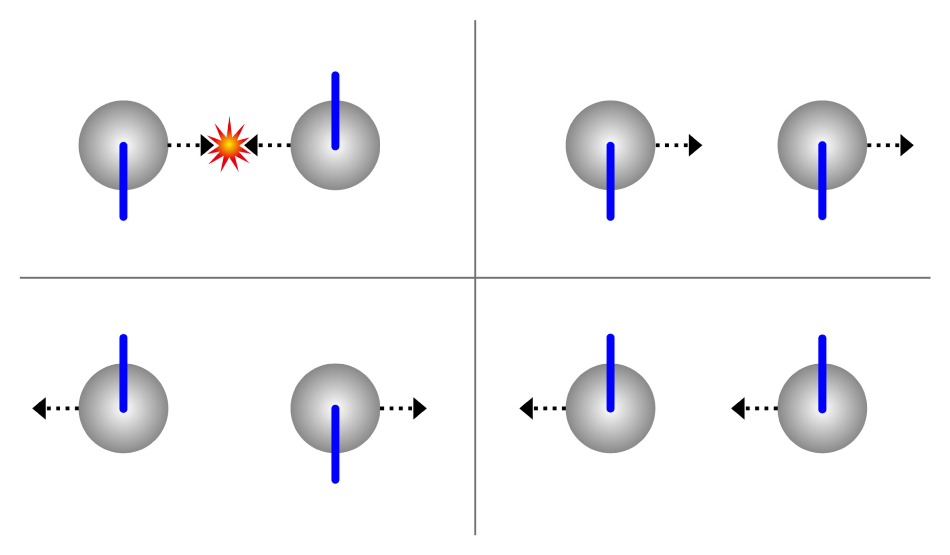May 11 2020
Matter acts in a predictable, anticipated manner in daily life. If a ball is thrown, one would normally assume that it will move in a specific direction and will have foreseeable recoil. Moreover, forces applied on one object would have no impact on another separate object.
 A particle’s spin influences the direction it will move. If the two particles move in certain directions, they will collide with each other and further impact the direction they move, as is shown in the top left. Image Credit: Okinawa Institute of Science and Technology Graduate University.
A particle’s spin influences the direction it will move. If the two particles move in certain directions, they will collide with each other and further impact the direction they move, as is shown in the top left. Image Credit: Okinawa Institute of Science and Technology Graduate University.
However, the rules are totally different in quantum mechanics—the physics of the small particles. In the case of one, two, and three-particle systems, actions that occur in one spot can have a powerful impact on atoms located far away. While researchers still lack a complete understanding of this phenomenon, they are hoping to gain more insights by examining the behavior of these systems as well as the more intricate ones.
Scientists from the Quantum Systems Unit at the Okinawa Institute of Science and Technology Graduate University (OIST), together with colleagues from Durham University and the University College Dublin, replicated one of these systems, which uncovered the unexpected quantum states—ways through which particles organize on their own in isolated systems.
Published in New Journal of Physics, the researchers’ results can potentially have applications in quantum technologies.
If you throw a stone off a boat, the stone goes one way and the boat goes the other. In quantum mechanics, we can have much stronger correlations at much greater distances. It’s like if you put on one red sock and one green sock, then someone in Antarctica, who you’ve never met, would have to do the same. And our work has found new states with these very strong correlations, which can be controlled very well.
Thomas Busch, Professor and Head, Quantum Systems Unit, Okinawa Institute of Science and Technology Graduate University
Experimenting with Two Atoms
When researchers investigate macroscopic systems, they are likely to look at several particles, for example, 1023. Since there are so many particles, the researchers cannot keep a track of each atom and would be inclined to make assumptions. To prevent this problem, the scientists in this analysis employed another option.
We simulated a system with just two atoms. This provided a building block of the larger system, but we could control everything and see exactly what was happening. And, to further control this system, we considered super-cold atoms.
Ayaka Usui, Study First Author and PhD Student, Quantum Systems Unit, Okinawa Institute of Science and Technology Graduate University
Particles move around quite rapidly at room temperature. The warmer the temperature, the faster the particles move. Through laser cooling, such atoms can be slowed and thus cooled down until they reach virtually zero velocity and are therefore super-cold. For Ayaka and collaborators, this made it relatively easier to elucidate them in their simulations.
In such a system, the easiest thing that can be done by the particles is to collide with one another. This compels them to move around and alter their direction; however, particles also have a property known as spin. A particle’s spin is either pointing in an upward or downward direction and additionally impacts the way it moves—an effect known as spin-orbit coupling.
When the scientists replicated a system with a pair of two spin-orbit coupled, super-cold atoms, these novel states, with their highly powerful correlations, were exposed.
We have the systems with two-particles where you get these states and the ones with 1023 where you don’t. Somewhere along this long chain of adding particles, these new states go away.
Dr Thomás Fogarty, Postdoctoral Scholar, Quantum Systems Unit, Okinawa Institute of Science and Technology Graduate University
Engineering Further Insights
“Alongside the new states, we’ve discovered the formulas that describe this system exactly,” added Ayaka. “So now, we can engineer it.”
By identifying these formulas, the scientists have control over the system and they are currently planning to modify the parameters to observe the dynamics of the system.
“We’re going to split the system, so we have two of them,” Ayaka added. “We can use the strong correlations to help us measure the system. If we find one atom in one of the systems, we know the other one is also in that one, without measuring it, because they are tightly correlated.”
While this study is simply focusing on an insignificant aspect of the things that can be performed by quantum mechanics, it has various applications, Professor Busch stated.
“Quantum technologies need these correlations,” he elaborated. “These new states have the strongest non-classical correlations that we know, and we can engineer them. With this research, we could build more powerful computers. We could create measurement devices that measure tiny differences in gravity or electric pulses in the brain. There’re so many applications to work towards.”
In addition to Ayaka Usui, Dr Fogarty, and Professor Busch, the study also involved Dr Steve Campbell from the University College Dublin and Professor Simon Gardiner from Durham University.
Journal Reference:
Usui, A., et al. (2020) Spin–orbit coupling in the presence of strong atomic correlations. New Journal of Physics. doi.org/10.1088/1367-2630/ab6576.